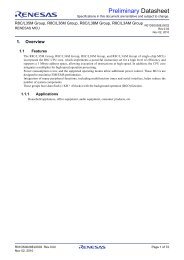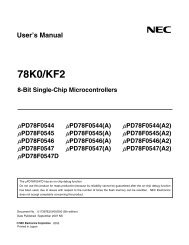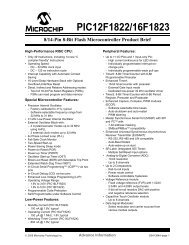xmega a3u - Elfa
xmega a3u - Elfa
xmega a3u - Elfa
You also want an ePaper? Increase the reach of your titles
YUMPU automatically turns print PDFs into web optimized ePapers that Google loves.
XMEGA A3U<br />
The I/O memory address for all peripherals and modules in XMEGA A3U is shown in the<br />
”Peripheral Module Address Map” on page 62.<br />
7.7.1 General Purpose I/O Registers<br />
The lowest 16 I/O memory addresses are reserved as general purpose I/O registers. These registers<br />
can be used for storing global variables and flags, as they are directly bit-accessible using<br />
the SBI, CBI, SBIS, and SBIC instructions.<br />
7.8 Data Memory and Bus Arbitration<br />
Since the data memory is organized as four separate sets of memories, the different bus masters<br />
(CPU, DMA controller read and DMA controller write, etc.) can access different memory<br />
sections at the same time.<br />
7.9 Memory Timing<br />
Read and write access to the I/O memory takes one CPU clock cycle. A write to SRAM takes<br />
one cycle, and a read from SRAM takes two cycles. For burst read (DMA), new data are available<br />
every cycle. EEPROM page load (write) takes one cycle, and three cycles are required for<br />
read. For burst read, new data are available every second cycle. Refer to the instruction summary<br />
for more details on instructions and instruction timing.<br />
7.10 Device ID and Revision<br />
Each device has a three-byte device ID. This ID identifies Atmel as the manufacturer of the<br />
device and the device type. A separate register contains the revision number of the device.<br />
7.11 JTAG Disable<br />
It is possible to disable the JTAG interface from the application software. This will prevent all<br />
external JTAG access to the device until the next device reset or until JTAG is enabled again<br />
from the application software. As long as JTAG is disabled, the I/O pins required for JTAG can<br />
be used as normal I/O pins.<br />
7.12 I/O Memory Protection<br />
Some features in the device are regarded as critical for safety in some applications. Due to this,<br />
it is possible to lock the I/O register related to the clock system, the event system, and the<br />
advanced waveform extensions. As long as the lock is enabled, all related I/O registers are<br />
locked and they can not be written from the application software. The lock registers themselves<br />
are protected by the configuration change protection mechanism.<br />
7.13 Flash and EEPROM Page Size<br />
The flash program memory and EEPROM data memory are organized in pages. The pages are<br />
word accessible for the flash and byte accessible for the EEPROM.<br />
Table 7-2 on page 16 shows the Flash Program Memory organization and Program Counter<br />
(PC) size. Flash write and erase operations are performed on one page at a time, while reading<br />
the Flash is done one byte at a time. For Flash access the Z-pointer (Z[m:n]) is used for addressing.<br />
The most significant bits in the address (FPAGE) give the page number and the least<br />
significant address bits (FWORD) give the word in the page.<br />
8386B–AVR–12/11<br />
15
















